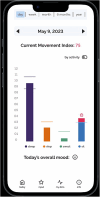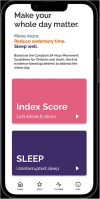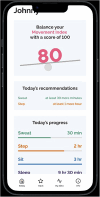Development of a 24-hour movement index: exploring acceptability among Canadian parents
- PMID: 40809100
- PMCID: PMC12344945
- DOI: 10.3389/fspor.2025.1571207
Development of a 24-hour movement index: exploring acceptability among Canadian parents
Abstract
Background: The Canadian 24-Hour Movement Guidelines for Children and Youth were introduced in 2016. They offer recommendations on moderate-to-vigorous physical activity, light physical activity, sedentary behaviour, and sleep in a typical 24-hour period to achieve optimal health outcomes. However, a lack of awareness and knowledge about the guidelines among children and parents is a concerning public health issue and may contribute to the low guideline adherence of Canadian children. A "Movement Index" app is planned to help parents track their children's movement behaviours through manual data entry and/or a wearable device. The Movement Index would also demonstrate to parents how the combination of their children's movement behaviours, such as a change in time reallocation, may be associated with different health outcomes. Using the Theoretical Framework of Acceptability, the objectives of this study were to (1) explore interest in, and acceptability of, the proposed Movement Index, and (2) identify potential refinements in developing the app.
Methods: Individual semi-structured interviews were conducted over Zoom with 22 parents of children aged 5-11 years from across Canada. Interview data were analyzed with thematic analysis using a constant comparative method.
Results: Results suggest that the Movement Index is acceptable on two constructs (perceived effectiveness, intervention coherence), mostly acceptable on two (affective attitude, ethicality), and has mixed acceptability for the remaining three (burden, opportunity cost, self-efficacy).
Discussion: On balance, the Movement Index was found to be acceptable, and the project should proceed with several caveats that need to be addressed regarding accessibility and ethical concerns. Future work is required to develop and pilot the Movement Index before further re-examining its acceptability and usability.
Keywords: acceptability; guidelines; knowledge translation; mobile health; monitoring; movement behaviours.
© 2025 Zhan, Khan, Tremblay and Faulkner.
Conflict of interest statement
The authors declare that the research was conducted in the absence of any commercial or financial relationships that could be construed as a potential conflict of interest.
Figures
Similar articles
-
Prescription of Controlled Substances: Benefits and Risks.2025 Jul 6. In: StatPearls [Internet]. Treasure Island (FL): StatPearls Publishing; 2025 Jan–. 2025 Jul 6. In: StatPearls [Internet]. Treasure Island (FL): StatPearls Publishing; 2025 Jan–. PMID: 30726003 Free Books & Documents.
-
Parents' and informal caregivers' views and experiences of communication about routine childhood vaccination: a synthesis of qualitative evidence.Cochrane Database Syst Rev. 2017 Feb 7;2(2):CD011787. doi: 10.1002/14651858.CD011787.pub2. Cochrane Database Syst Rev. 2017. PMID: 28169420 Free PMC article.
-
A digital intervention to improve mental health and interpersonal resilience for young people who have experienced online sexual abuse: the i-Minds non-randomised feasibility clinical trial and nested qualitative study.Health Soc Care Deliv Res. 2025 Jul;13(28):1-27. doi: 10.3310/THAL8732. Health Soc Care Deliv Res. 2025. PMID: 40754856
-
Falls prevention interventions for community-dwelling older adults: systematic review and meta-analysis of benefits, harms, and patient values and preferences.Syst Rev. 2024 Nov 26;13(1):289. doi: 10.1186/s13643-024-02681-3. Syst Rev. 2024. PMID: 39593159 Free PMC article.
-
Comparison of self-administered survey questionnaire responses collected using mobile apps versus other methods.Cochrane Database Syst Rev. 2015 Jul 27;2015(7):MR000042. doi: 10.1002/14651858.MR000042.pub2. Cochrane Database Syst Rev. 2015. PMID: 26212714 Free PMC article.
References
-
- World Health Organization. Global action plan on physical activity 2018–2030: more active people for a healthier world. Geneva: World Health Organization; (2019)
LinkOut - more resources
Full Text Sources





